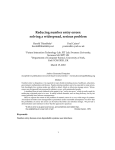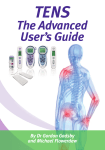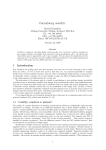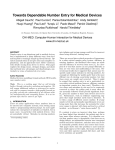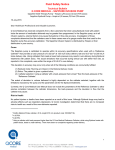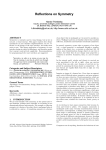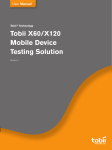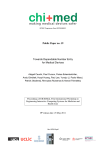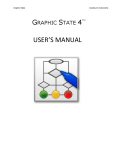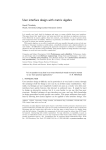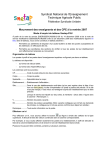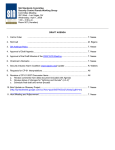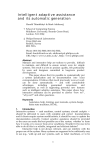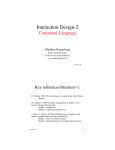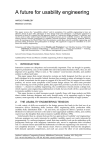Download draft pdf - uclic - University College London
Transcript
Applying Graph Theory to Interaction Design Harold Thimbleby1 and Jeremy Gow2 1 University of Swansea, [email protected] 2 University College London, [email protected] Abstract. Graph theory provides a substantial resource for a diverse range of quantitative and qualitative usability measures that can be used for evaluating recovery from error, informing design tradeoffs, probing topics for user training, and so on. Graph theory is a straight-forward, practical and flexible way to implement real interactive systems. Hence, graph theory complements other approaches to formal HCI, such as theorem proving and model checking, which have a less direct relation to interaction. This paper gives concrete examples based on the analysis of a real non-trivial interactive device, a medical syringe pump, itself modelled as a graph. New ideas to HCI (such as small world graphs) are introduced, which may stimulate further research. 1 Introduction A fundamental idea in HCI is that users build mental models of the devices they interact with. Often one can do useful work with quite vague notions of mental and device model, but low-level device features have high-level cognitive effects [11]. For rigorous HCI work, and particularly with safety critical devices and tasks, then, it is essential to have a very clear notion of what the device model is. Unfortunately much work in design, specification and verification of interactive systems uses abstract or incomplete models of devices. What is needed is an approach that can represent full, concrete devices and which has value for analysis of interaction. If we restrict ourselves to devices that are implemented by computer programs, then the programs (in their given languages) are the final arbiters of the device models. Unfortunately, typical programs do not lend themselves to defining clear device models. Programs (and their specifications) are for instructing computers, not for defining user interface behaviour, which in fact happens as a side-effect of running them. Hardly any code in a typical program has anything explicitly to do with the behaviour of the user interface, and typically the code for the user interface is widely distributed throughout the program: there is no single place where interaction is defined. Graphs are a mathematical concept that lend themselves to analysis and interpretation by program. A large class of interactive system can be built concisely from graphs—and it is a trivial theorem that any digital computer system 2 is isomorphic to a graph and a simple state variable. Significantly, as this paper shows, graphs lend themselves very well to a wide variety of analysis highly relevant to HCI concerns. For example: – Sequences of user actions are paths in a graph. A standard graph theoretic concept is the shortest path between two vertices, which defines the most efficient way a user can achieve a particular change of state. If there is no such path, then a user cannot achieve the state change. – The transition matrix M of a graph gives the number of ways a user can cause a state transition by doing exactly one action. The matrix M n is the number of ways of achieving any state transition with exactly n actions; and Pk i M is the number of ways of achieving any transition with 1, 2, 3 . . . k i=1 actions. The higher the number of ways of achieving a state transition, the easier the state is for the user to reach. A safeP (a secure interactive device) would typically have only 0 and 1 entries in M i , whereas a permissive device [15] would have comparatively large entries. In short, graphs very readily simultaneously define interactive systems and usability properties. Graph theory connects formal specification, runnable programs (or prototypes) and HCI. This paper backs up this claim with a wideranging analysis of a working simulation of a real, non-trivial interactive device. 1.1 Graph-based approaches Although the use of transition systems to specify interactive systems was proposed as early as 1960 [10], they did not catch on as a ‘pure’ formalism because of their apparent limitations for user interface management systems (UIMS)— leading to a line of research [20, etc] that was overtaken by modern rapid application development (RAD) environments [9]. However, the drive behind both UIMS and RAD environments was programmability and flexibility rather than rigor. In rigorous HCI, one needs a programming framework that is both analytic and close to the user interface, if not identical with it: graphs achieve this goal. Graph theory was proposed for use in HCI in [13, 14] as a means of analysis; other work includes using graph theory for providing interactive intelligent help [18], and using flowgraph concepts to analyse user manuals as structured programs [17]. Graph theory is a substantial area of mathematics, and many interesting theorems and properties are known for graphs that can readily be programmed on a computer (see, e.g., [2, 7, 12]). A graph is readily represented by drawing vertices as dots, and arcs as arrows joining dots. Vertex and arc labels are written as words adjacent to the vertices and arcs. If vertices are drawn as circles or other shapes, their labels can be written inside the shapes. Small graphs are easy to draw by hand and larger graphs can be drawn automatically using appropriate tools [3]. To avoid clutter labels are sometimes omitted. Reflexive arcs (also called trivial arcs) that point back to the same vertex are also often omitted for clarity. 3 2 Graphs and interactive systems We use labeled directed multigraphs in this paper, but what is a graph and how does it relate to an interactive device? A labeled directed multigraph is a set of objects called vertices V , a collection of arcs A ⊆ V × V which are ordered pairs of vertices, and two total functions `V : V → LV and `A : A → LA that map vertices, respectively arcs, to sets of labels, which name the vertices and arcs. The graph theoretic terms are vertices and arcs, but the device or programming terminology usually refers to vertices as states and arcs as transitions; the user terminology refers to arcs as actions. Formally there is no difference. However, for most devices, the user cannot uniquely identify the state of the device. Instead, the user can observe (hear or feel) indicators. We model this as a mapping O from vertices to the powerset of available indicators I, O: V → P PI. That is, in a given state s, O(s) is the set of indicators that are ‘shown’ to the user. An interactive device can be represented straight forwardly as a directed graph assuming: user actions are mapped into arcs, states are mapped into effects the user can observe (for instance with sounds or indicator lights) and the device must track the current state using a variable. When the user performs an action, the current state A is changed to the next state B where there is a directed arc from A to B labeled with that action. Arcs may point back to the same state, and the transition then does not change the state; if the next state is A we say that the action is guarded in A as no non-trivial transition occurs. Graph models may be non-deterministic—either because of the underlying system or because of constraints on the modeling process—in which case one of several possible next states will be arrived at. Although useful, non-determinism complicates many our of our graph metrics, and is beyond the scope of the current paper. Graph models can be extended with other concrete representational details to relate them to actual interactive systems. For example an image can act as a device’s skin, e.g., as used with the Java model shown in Figure 1. Changes to the skin during use can be captured by indicator skins—changes to the skin which correspond to the activation of individual indicators. Although an important practical consideration, skins make little impact on our approach. To be formal, devices are considered finite state automata represented by a 10-tuple hV, LV , `V , A, LA , `A , O, I, s0 , S, IS , iS i, with (in addition to the components already introduced above) s0 the initial state (the state a device is in before it is first used), S the skin (which for our purposes is a colour image), and IS a bijection from vertices to indicator skins iS . This level of formality may look pedantic, but there is an important point: precisely this information is sufficient to build a functioning interactive simulation (and even a user manual) and to analyse its usability and other properties in depth. The fruitfulness of this approach is explored throughout this paper. In what follows, we will use the terms state and vertex interchangeably, but stylistically we use state for user-related issues and vertex for graph theoretic 4 issues. Similarly, we will use action, press, etc, for user actions, but arc for the corresponding graph concept. Typographically, we shall write State and Action . 2.1 Case study A syringe is used to give patients injections of drugs. A syringe pump is an automatic device that uses a motor to drive the syringe, and gives a patient an injection usually over a period of hours or even days. The pump is set up by a nurse or anæsthetist to deliver drugs for various conditions: for example, so that it can be used on demand by a patient for pain management. Some pumps have detailed models of drug uptake in the patient (the patient weight having been entered), and may be used for anæsthesia. An ambulatory pump is one that a patient can wear or carry around, and is typically used for pain management by delivering calibrated dosages of drug on demand—within parameters set up by the nurse, particularly so that the patient cannot overdose. This paper uses as a running example a simulation of the main features of the Graseby ambulatory syringe pump type 9500 [5]. The simulation of the Graseby pump has been implemented as a Java program, constructed explicitly from a graph model (of 54 vertices and 157 non-trivial arcs)—it is an example of a realistic-scale, safety critical interactive system, and thanks to its graph-based definition, with a formal specification that corresponds directly to its interaction behaviour. See Figure 1 for a screen-shot of the Graseby simulation, and Figure 2 for a representation of its graph. For reasons of space, we only use this one example system; in general a designer would have a collection of systems and compare properties for variations of the basic design. Clearly a very important practical use of graph theory is to compare designs, particularly a design and iterative variations of it. For reasons of space, we make no design comparisons here. The remainder of the paper discusses some of the user issues that can investigated using graph theoretic properties—some of them standard, others of special interest to HCI, and some of the potentially opening up new research areas within HCI. 3 Navigation First, we look at graph metrics related to the user’s ability to navigate the device’s state space. 3.1 Reachability A graph is strongly connected if there is a directed path connecting each pair of vertices; in other words, the user can get from any state to any other state. There are no dead-ends, and no unreachable states. The Graseby is indeed strongly connected. 5 Fig. 1. Partial screen shot of the simulation—a user can mouse click on the buttons, which are animated to give simple visual feedback of pressing. Note that graph theory does not address all HCI issues, such as the naming or confusibility of buttons. For many real devices, a weaker property is important: every state can be reached from a certain set of states S, typically including a standby or off state. For example, it is important that a fire extinguisher can be used from Standby, but once used it cannot be returned to Standby by the user—it needs recharging. This property can be expressed in many ways, for example for every vertex v ∈ S there is a spanning tree rooted at v. An example from desktop PCs is that one wants to be able to write any document starting from a new, empty document. If a graph is not strongly connected, it will have at least two strongly connected components. If each strongly connected component is contracted to a single vertex, the resulting graph must be acyclic (in fact a DAG). A designer may use this concept in three ways: first, to check that all states are reachable (otherwise the device has features that cannot be used); secondly, to determine the set of states that can reach selected states. All connectivity properties can be conveniently determined from the all-pairs shortest paths matrix, P , readily found by Dijkstra’s algorithm. If there is a path from u to v, then Puv will be finite, and moreover Puv is the minimum number of user actions to perform the appropriate state transition. A graph is strongly connected if and only if all elements of P are finite. The characteristic path length, a property we use below (in §3.3), is the average of elements in P . 3.2 Diameter and radius The diameter and radius of a graph are defined in terms of eccentricities. The eccentricity of a vertex is the distance to the furthest vertex from it; more precisely it is the longest shortest path between it and all vertices. The diameter of a graph is then its greatest eccentricity, and the radius is its least eccentricity. 6 Off On Press PURGE again for On Value locked for On Access code for On Purging for On PCEA bolus Change lock for On Press PURGE again for PCEA bolus Purging for PCEA bolus Access code for PCEA bolus Value locked for PCEA bolus Change lock for PCEA bolus PCEA rate Access code for PCEA rate Change lock for PCEA rate Value locked for Lockout time Continuous Value locked for Continuous Purging for PCEA rate Value locked for PCEA rate Lockout time Press PURGE again for Lockout time Purging for Lockout time Press PURGE again for Continuous Reset Press PURGE again for PCEA rate Purging for Continuous Press PURGE again for Reset Access code for Reset Purging for Reset Change lock for Reset Access code for Lockout time Change lock for Lockout time Access code for Continuous Change lock for Continuous Value locked for Reset Good PCEA Access code for Good PCEA Change lock for Good PCEA Press PURGE again for Good PCEA Value locked for Good PCEA Purging for Good PCEA Reset totals Value locked for Reset totals Infusing Bolus Infusion suspended Access code for Reset totals Change lock for Reset totals Press PURGE again for Reset totals Purging for Reset totals Access code for Infusing Clinician bolus Fig. 2. Illustrative visualisation, drawn by Dot concurrently with a running simulation. The reduced diagram here is not particularly readable, but the graph visualisation program allows the diagram to be zoomed and scrolled, so very large graphs can be handled conveniently. In our system, previously visited states are shown in yellow, and the current state is in red (though monochrome reproduction of this paper will may make all such states look grey). In usability terms, the diameter represents the difficulty, counted in actions, to the user of the worst task (or tasks) they can do on the device. The radius is the difficulty of the ‘easiest hardest’ thing to do. Of course, ‘difficulty’ is a formal term; in fact, users will make mistakes, or not know the best way of achieving their tasks—the eccentricity represents an optimal, error-free, fully knowledgeable user, and thus a lower bound on difficulty. However, it is not difficult for graph measures to be conventional usability metrics, such as time; for example, the Fitts law can estimate the time for the user to execute all actions along any path. The diameter and radius can be used to define two interesting sets of states, based on eccentricity. The centre of a graph is the set of vertices with eccentricity equal to the radius; whereas the periphery is the set of vertices with eccentricity equal to the diameter. The diameter of the Graseby graph is 8 and its radius is 5. The centre of the Graseby is the single state On. This state is reached from Off by pressing the On button; in other words, as soon as the Graseby is switched on, it is in the (as it happens, unique) state where everything is as easy as it can be. The Graseby has a periphery of 15 states, 8 of which are concerned with patient controlled analgesia (PCA). Arguably, the patient features of the device should be simpler in some sense than the nurse or anæsthetist features; the analysis highlights this potential design concern. On the other hand, the Graseby has several modes—it can be unlocked, half locked or fully locked—that restrict 7 to varying degrees what a patient can do. It would be possible to work out the periphery under each lock condition, but we will not do so here (as we are illustrating the use of the graph theory techniques for usability analysis, not evaluating the device). 3.3 Small world graphs A small world graph is one that has an unusually small average shortest path between all pairs of vertices. The classic small world example is the social graph of relationships: ‘six degrees’ is the (popular) mean least number of familiar relations between any two people. Whether the number is exactly 6 or not, for a graph with as many vertices as people and as sparsely connected, it is remarkable that this characteristic path length (the mean shortest path length) is so low. Small world metrics are relevant to HCI because a device may have a huge number of states, but it should still have a modest expected cost of getting from any state to any other. In other words, a small world device is usable—and easier to use than an equal sized non-small world graph. There are many small world metrics, all of which are easy to measure. Thus the characteristic path length of the Graseby is 4.1, indicating a relatively small expected cost for navigating the device. We discuss more benefits of small world graphs in §4.5 and §5.2. 3.4 Completeness A complete graph has an arc connecting each pair of vertices; it is possible for a user to get from any state to any other state in a single action. There must be at least N − 1 user actions for an N state device. In particular, if there are at least N actions, they may be conveniently labeled with the name of the target state. The complete graph Kn of n vertices is unique up to isomorphism. The complete graph K2 is familiar as the on/off graph, and indeed the states are usually called On and Off, and the action labels can be unambiguously called On and Off . A designer may wish to check the propery of directness, namely that every arc label `A (uv) satisfies the property `A (uv) ⇒ `V (v), with ⇒ appropriately defined to correspond to ‘perceptual’ or ‘cognitive’ implication. For example, in the on/off device described above, if the user does On , they might expect the device will enter the state On; or put formally, On ⇒ `V (On). Of course by design we should have On = `A (Off On), as well as ⇒ `V (On). In general, directness will make a device easy to use but it implies the device has enough distinct actions, and for a complex device the designer will have to choose which actions are direct and which indirect. For many devices, however complex, Off is typically a direct action. On the other hand, directness permits a device to have more action labels than states, for instance to provide alternative ways to get to a state. A designer would probably require, further, that for every arc label there is an appropriately labeled out-arc from every vertex—otherwise some actions will not work in some states. 8 The advantage of a complete graph is that anything the user might want to do can be done in exactly one action; conversely, there is a problem: the user cannot be guarded from any side-effects, nor can there be any security as no states can specifically guard any others. Furthermore, since there are at least as many actions as states, the number of states may be limited for physical reasons: on a push button interface, 100 states would require at least 100 buttons which may be impractical simply in terms of space. A more interesting design issue for a direct complete graph is that in every state there is one button that does nothing—though the user can always press a button X to achieve state X regardless of whether the device is in state X already. Most devices are not complete, however. In this case, we can automatically identify complete subgraphs, and then test the subgraphs for the appropriate properties. 4 Errors Graph theory lends itself to analysing the nature and costs of various error scenarios a designer may be interested in. 4.1 Undo cost The undo cost of a device can be defined as the average cost of recovering from a single action error. If a user presses a button by mistake, on average, what is the recovery cost for them? The undo cost is the average of the least cost of recovering; in practice a user would take more than the undo cost because they will be unlikely to know the device perfectly (and in any case they may be stressed after making an error, and may make further errors). The undo cost of the Graseby is 2.0; if it had an Undo button, the undo cost would be 1, and the risk of user stress (and further keying errors) increasing the cost would be eliminated. The undo cost is measured by finding the all pairs shortest paths using them to find the average cost of paths corresponding to every graph arc reversed. There are clearly two sorts of undo cost: the basic undo cost is the average cost of undoing any action—but of course, some actions do nothing (the arcs are loops), so the normal undo cost is the average cost of undoing an action that has done something. Further, the basic undo cost can be refined: if the user does not notice an action has no effect, but they still want to undo it, then the undo cost for that action is at least 1 not 0. We could also weight costs with the probability the device is in particular states—for example, if it is less likely the user will get the device in an Alarm state, then the cost recovering from errors in this state should be weighted less. Which undo cost is the most insightful measure for a device depends on the domain, or a designer may wish to compare different undo costs to improve device performance, particularly if some forms of undo cost are significantly higher than others which would indicate they deserve closer inspection by the designer or analyst. 9 4.2 Undo equivalents For a device like the Graseby, which does not have a specific Undo action, it may be interesting to know which action or actions most often behave like an undo. For example, one might expect UP and DOWN to be mutual undos. For the Graseby, the most common action that behaves like Undo is in fact Timeout : in other words, to recover from many errors, the user should simply wait until the device times out. In graph theory terms, for all arcs (uv) on the Graseby if there is a reverse arc (vu) most such arcs are labeled Timeout . The user should be trained to know the significance of timeout, since trying to do anything to recover from an error merely delays the device doing the timeout. Also, the design of the device might be modified to tell the user (e.g., by way of an indicator) that a non-trivial timeout is possible in the current state, and moreover when the timeout would in fact behave like Undo . 4.3 Overrun cost The undo cost of a device is the average cost of recovering from any error. In contrast, the overrun cost of a device is the undo cost assuming that the errors the user will undo are overrun errors: the average cost of recovering from doing an action once too often. Many tasks require a user to press a button repeatedly, and it is very easy to press a button once too often. Or the user may press a button and not be sure they pressed it hard enough, so they press it again; now they have pressed it twice. The overrun cost is specified as the average over all possible recovery costs: for all labels l, for every arc (uv) labeled l, if there is an arc (vw) also labeled l find the cost of the shortest path w to v. The overrun cost for the Graseby is 1.66, which is better than the undo cost (which is 2). In other words, certain sorts of error (overrun being one) are easier to undo than average. The designer should collect some empirical data to find out what sort of errors users typically make. It is also important to know how users typically recover from errors. 4.4 On/off or reset recovery cost Often a user will switch a device off and on again in their attempt to recover from an error (interviews with anæsthetists confirm it is standard practice). The optimal cost of an off/on recovery procedure is the cost of getting to Off (in general, at least one action) followed by returning to the previous state—there’s no point returning to the error state. The appropriate cost measure is therefore the average of: for every state u and arc (uv), the cost of the shortest path from v to Off then Off to u. For the Graseby, this reset recovery cost is 4.85 with a worst case cost of 7. Interestingly, these figures are little different from the characteristic path length (4.1, and worst case 8), so a user switching this device off and on again is not much worse than the average cost of doing anything— the anæsthetists’ strategy seems sensible (and maybe a strategy one wishes to deliberately support by design). 10 In all cases above, we have assumed the user knows the optimal ways to achieve everything and that they can do the sequence of actions accurately, else their choices of actions will not be optimal, as the measures above assume. It is possible to measure costs based of assumptions of stochastic user behaviour, and this has been done at length elsewhere [1]. 4.5 Errors in small world graphs One measure of small world graphs (discussed in §3.3) is the cluster coefficient [21], the probability that two neighbours of a vertex are connected. The cluster coefficient can be considered to represent how easy it is for a user to correct a single incorrect action: that is, by doing something, they move from a state to its neighborhood, and if they wanted to be somewhere else in the neighborhood (anywhere else one action away from where they were), the coefficient is the probability they can get there with just one further action. The Graseby’s cluster coefficient is 0.6. The cluster coefficient is the average of all vertex clustering, but it is interesting to find the worst cases, since low clustering makes a state harder to ‘adjust,’ certainly harder to move around in its neighborhood, than a state with high clustering. For the Graseby, the three worst cases in this sense are Infusing, Infusion suspended, and Continuous—interestingly, all these states occur when the device is clinically active, where we can assume the operator does not want to change its mode either easily or accidentally (and this property is indeed what we find in the graph); whereas high clustering states are in fact highly ‘interactive’ parts of the Graseby, like Off, Purging and Bolus, all states whose clinical use is transient. 5 Knowledge We can expect interactive systems to be easier to learn and comprehend the smaller they are, and the more regular their structure. We now look at other graph properties that relate to user knowledge—and that identify key areas for training. 5.1 Edge connectivity The edge connectivity of a graph is the minimum number of edges whose deletion would disconnect the graph; one distinguishes between connectivity and strong connectivity (see §3.1), depending on whether edge direction is taken into account. For the Graseby, the strong edge connectivity is 1. This means that if a user does not know one particular arc, the system (or, rather, the user’s model of the system) is effectively disconnected, and therefore there are some operations the user does not know how to do. The minimum cut is the set of arcs (namely the bridges) that disconnects the graph. For the Graseby, the minimum cut is a single arc, the On for the 11 state transition Off to On. We have thus automatically discovered what is (in hindsight) an obvious fact: if a user does not know how to switch on the Graseby (i.e., they do not know this action in this state), there are some operations they certainly cannot do! If a device is not going to be redesigned, the edge connectivity and its dual, the vertex connectivity (and the set of hinges, vertices whose deletion disconnect the graph), highlight potential training issues. For many applications, most important thing to teach the user is the minimum cut, for this is the ‘simplest’ knowledge not knowing which will make the device very hard if not impossible to use. 5.2 Knowledge in small worlds graphs Small world graphs (discussed in §3.3 and §4.5) have interesting properties relevant to usability. They are resilient to failure (‘network robustness’). If a user does not know about some state, (on average) they can still find short paths from where they are to where they want to go. Small world graphs have characteristic vertices called hubs, which are very strongly connected. If a user knows of one or more hubs, they will find a device very easy to use, because knowing a hub makes connection to many other states very easy. While not knowing about a hub can make a device very hard to use, knowing it makes using it much easier. Hubs are therefore worth identifying for training purposes. Not surprisingly, the main hub for the Graseby is the Off state, followed by On and Infusing. Small world graphs apparently have usability benefits (for reasons as outlined above), and interestingly they arise naturally through incremental product development. For example, a new feature is likely to be attached adjacent to an existing hub vertex, therefore strengthening its role as a hub. One might therefore expect an iterative design process to develop a small world graph—this may be another reason to suppose that iterative design is a central design method for good HCI [4]. 5.3 Planar graphs and user comprehension A colouring of a graph is an assignment of labels (e.g., red, green. . . ) to vertices of a graph such that no adjacent vertex has the same colour. The chromatic number of a graph G is the minimum number of labels that colours G. The most famous theorem of graph theory is the Four Colour Theorem, first proposed in 1852 but only proved in 1976, which states that a planar graph (i.e., a graph that can be drawn in the plane without any cross-overs, bridges or tunnels) has a chromatic number at most 4. A graph with unavoidably crossing arcs may have a higher chromatic number. One reason to think planarity and chromatic numbers are relevant to usability is a conjecture about user comprehension: if the transition diagram of a device can be drawn with no crossing arcs, the diagram must in some sense be easier to understand. In fact the Graseby is not a planar graph, so drawing it (as in 12 Figure 2) inevitably requires some crossing lines. We look at another application of chromatic numbers in the next section. 6 Observability We can use chromatic numbers (§5.3) to think about what the user can, in the best case, observe about an interactive system. Although the Graseby is not planar (see above), nevertheless its chromatic number is 4. If we imagine the user could see each state’s colour and nothing else, then if fewer than 4 colours had been used, the user would not be able to tell when the device changed between some states. If the device displays the current state by some combination of lights (e.g., LEDs) or text such as ‘pumping,’ ‘alarm,’ ‘on’ and so on, then its chromatic number is the minimum number of combinations of indicators that are required to communicate every state change to the user. More specifically, a system with chromatic number k needs at least dlog2 ke indicators, e.g. lights or different texts. In fact the Graseby has no lights, but it does have an LCD panel that helps distinguish adjacent states. 6.1 Trackable and knowable systems We may define a continuum of usability, delimited by three important properties of a device being untrackable, trackable or knowable. A trackable device allows the user to keep track of which state it is in, provided the user knows what they are doing; a knowable device allows the user to determine which state the device is in. If the number of distinct indicators in n, then a device is untrackable if 2n < k the chromatic number. A device is in principle trackable if 2n ≥ k, but it is not knowable at least until 2n > N where N is the number of states. In practice a device may allocate the n indicators in a peculiar way, so that the bounds are not realised. Thus we distinguish between trackable in principle (i.e., there are enough indicators) and trackable in practice (the indicators work such that every adjacent state has a different permutation of indicators); knowable, of course, means that every state, whether adjacent or not, has a different permutation. If adjacent (respectively, any) states do not have different indicators, then this suggests to the designer either there are too many states, too many arcs, the indicators or the indicator mapping, O, are badly designed. The Graseby is trackable but not knowable (in the sense defined above). We can characterise trackable systems more precisely by looking at the average cost of knowing the state, i.e., the average number of user actions required to uniquely identify the current state. The higher this is the more difficult a user will find it to orient themselves when coming to the system in an arbitrary state, say, after a distraction. The maximum cost of knowing the state is also of interest here. 13 6.2 Chinese postman tour The Chinese postman tour (abbreviated CPT) finds the shortest tour that visits every arc of a graph [16]. A person (whether designer or user) who claims to know a device must in principle know a Chinese postman tour—though in practice they need not be able to describe it (a standard psychological issue of being skilled but unable to explain the skill in detail—see the discussion below on the ‘practical’ CPT). The length of a CPT is a strict lower bound on the knowledge needed to be certain a user (or designer) knows a device. Reducing the CPT cost will therefore in general suggest or highlight potential improvements to a designer. The length of the CPT for the Graseby is 710 button presses, not counting details such as password entry. This seems very long, and suggests the Graseby is unlikely to be understood fully by any users unless it has been designed with some systematic structure (which the CPT does not exploit). For example, the CPT must check every Off action for every state; presumably most devices are designed in such a way to ensure this property without needing to check it explicitly. The nature of the CPT is clear from the following extract from the middle of a tour of the Graseby: : 478 Try ON from "Off" goes to "On" 479 Try DOWN from "On" goes to "Value locked for On" In state "Value locked for On", check unused buttons: DOWN, OFF, PURGE, UP, STOP, KEY, ON do nothing 487 Do ENTER from "Value locked for On" goes to "Continuous" : An implementor of a reverse-engineered device may wish to run through the CPT on both the device and the simulator to check that they correspond. Notice that doing a CPT may require testing many timeout transitions (24, or about five minutes total, for the Graseby or, rather, 24 as known from the simulation—the real Graseby may require more), and therefore checking may take a very long time! Note, also, that the state names listed in the CPT are the implementation’s state names, and these may or may not correspond closely to the device state names, if indeed the device makes it clear to users what state it is in (the Graseby uses a large LCD, which mostly displays text unique to the current state). If a graph is Eulerian, it has a CPT of minimal length, namely a Eulerian tour, with each arc traversed exactly once (a CPT in general traverses some arcs more than once, therefore making it longer than a Euler tour). The Graseby is not Eulerian, and therefore some arcs must be revisited in a CPT. The CPT algorithm can determine the minimum number of arcs to adjoin to make a graph Eulerian; for the Graseby, this number is 30. Therefore long revisited paths could be designed-out of the CPT provided there are ‘spare’ out-arcs from vertices: namely, vertices with out-degree less than the number of user actions. It is trivial to modify a CPT algorithm to identify 14 candidate pairs of vertices, but of course one would not necessarily want more arcs out of, say, the state Off than the single arc labeled On ! Or again, some buttons have labels that characterise the states they go to, such as On goes to the On state (if the device was off); it does nothing else on the Graseby, but the CPT analysis suggests it could do more—but a user would probably not want On to do anything else. The designer must therefore use discretion in interpreting the suggestions—for the Graseby, perhaps an arc labeled Start could usefully start an infusion even if the device was off, thus adding one more arc to Off and reducing the length of the CPT, and hence making the device easier to learn thoroughly. 6.3 Traveling salesman tour The postman visits every arc (as it were, visiting every street/arc to deliver post), whereas the salesman visits every vertex (as it were, selling stuff in every city/vertex). The traveling salesman problem is to find the shortest tour that visits every vertex. In user interface terms, this corresponds to visiting every state to check it works as intended (if a designer) or that it is understood (if a user). Assuming the actions are consistently designed, visiting every state may be sufficient to understand a device—the CPT is overkill on this assumption, as it assesses too much detail. 6.4 Practical tours If the CPT of the Graseby is 700+ user actions, this may be a useful indicator of the complexity of the user interface, particularly when compared to other designs or modified Graseby designs, but in practical terms the large number means a designer is unlikely to be able to follow the tour without making errors; they are also unlikely to be able to follow the tour in a single session. In either case, a more practical approach is required. The Graseby simulation tracks which states and actions have been visited and used. Hence, rather than follow an error-free tour, the designer can follow a dynamicallygenerated tour that suggests their next action(s) to take the shortest path to the next unchecked part of the device, given that the simulation knows which states and arcs have already been checked (cf. Figure 2). More generally, since a design may change (or a simulation modified to be made more faithful to an actual device), the flags associated with every vertex and arc can be reset if the design changes and the change affects that item. Thus a designer can incrementally check a device, even while it changes, perhaps making errors or missing actions, and still know what needs doing—and eventually cover the entire functionality of the device. The flags can be used in two further ways. During design, other documents may be produced, such as user manuals. A technical author may wish to flag that they have already documented certain parts of the device, and therefore that they must be notified if the flagged parts of the device change. Another use is for an auditor, who checks whether an implementation conforms to its specification. Again, they can use flags to assert that a vertex (or arc) has been checked out and must not be changed gratuitously. Both these ideas are implemented in [19]. 15 7 History and undo A disadvantage of graph theoretic formalisms is that there are some standard user interface features that are cumbersome (but not impossible) to represent: history and undo. Many devices ‘remember’ what they were doing before they were switched off; when they are switched on again, they go back to the state they were in before being switched off. (Statecharts represent this history by using a special notation.) Graphs can only represent this remembered history by embedding it as a subgraph within the Off state. If there is only one state that maintains a history, this is not a serious issue, but when there are several, the complexity of the subgraphs becomes hard to manage without help. Many desktop applications, but surprisingly few interactive devices, support undo— which is curious given that undo has considerable benefits for users, and is particularly easy to implement for interactive devices. The simplest way to implement a device based on a graph was described above: the device tracks the current state using a variable s. To implement undo, the device model is changed from finite state automaton (§2) to push down automaton, such that on every state change s is pushed on the stack. The action Undo simply pops the stack to update s. If undo is implemented like this, then the graph model does not represent undo, and it would be transparent to any analysis based on the graph. An alternative approach is to modify the basic graph to support undo. (This is an example of the general procedure of taking a device specification as a graph and introducing some required feature, in this case undo.) An undo graph can be defined informally: given a graph g, the undo graph U (g) replaces every vertex v of g with a set of n vertices U (v) where n is the in-degree of v. Each vertex in U (v) has exactly one incident arc, and the same out arcs as v together with an additional arc labeled undo that returns to the source of the incident arc. Generally U will be applied to a subgraph—for example, we do not generally require Undo to work if the last action was Off . History (as in statecharts) is much harder to conceptualise in graph theoretic terms. For every component of n vertices with a history, n copies of every other vertex must be made; essentially if a graph has two components U and V , with V having a history, then U must be replaced by U × V . In practice many devices have history. A common example is a TV that returns to the last channel watched when it is switched on: implying the Off state is a set of 100 or so vertices, so the single on transition from each off vertex can return to the last-used channel. 8 Misconceptions One might imagine that graphs have disadvantages because many graph properties are computationally hard. For example, if we allow arcs to be conditional on arbitrary conditions (as they are in statecharts and Kripke models) then many otherwise routine graph theoretic properties turn on undecidable questions. Or finding the largest cycle in a graph is an NP-complete problem. On the other hand, any such property would be correspondingly hard in any other formalism too. In short, the disadvantage of graphs, if any, is not that some properties are hard, but that it can be deceptively easy to express hard properties! 16 An astronomical number of vertices may be needed to represent some programs. One might therefore imagine that graphs for real systems would necessarily be enormous, and impractically so. This, however need not be a problem in practice, for at least two reasons. First, we do not need to represent graphs explicitly: for example, SMV has an underlying model (a Kripke model) but a typical user of SMV would never see it, nor its efficient representation as a BDD. Second, whatever the theoretical potential for detailed representation, we as HCI evaluators need only use graphs to model the user interface behaviour (not the underlying model in the MVC sense). Such graphs are much smaller; indeed, a user interface that required a user to know or model billions of states would certainly be unusable! Instead, users model an abstraction of the implementation; to the extent we can capture that abstraction graphs will be an ideal tool to model user interfaces. 9 Further work Further work can be divided into three areas: the development of convenient APIs, CASE tools or languages for programming interactive systems, the development of convenient analysis tools (particularly ones that do not require mathematical expertise to use), and further research into the underlying principles and the usability/model correspondences. As for specific further research, the following ideas might be considered: – There are many ways in which user testing could validate the use of graph theory in HCI and to provide a better understanding of its use in redesign, e.g., priorities in different design contexts, relationship to other methods. Although graph theory has strong face validity, and there are cases where its use may be critical to safety, we do not know how useful it is given the huge number of other pressing design issues that confront real projects; on the other hand, all graph theoretic measures can be automated, and doing so would be a first step towards testing validity experimentally. – Of the ‘off the shelf’ graph theoretic properties that are useful for HCI, define them in CTL or other logic (see [8] for some examples). Doing this would produce a useful collection of design principles, and perhaps even a benchmark collection for proposed HCI methods. – Since history and undo are operations on graphs, an interesting research project would be to optimise algorithmic graph theory for such graphs. For example, shortest paths are unchanged by undo, and therefore can be found as efficiently in a graph with undo as without provided the underlying graph is known. – The user model and the user manual can be represented as graphs. What properties do such graphs have, and what are useful relations between these graphs and the system implementation graph? For example: if the user model is a subgraph of the system, the user need ‘never’ make a conceptual mistake with it; if the user manual is a spanning tree of the system, it describes it ‘fully.’ – We identified small world graphs as being relevant to navigation, error and knowledge. These graphs, and scale-free networks, seem highly relevant to HCI, but this relationship has not yet been explored thoroughly. – The states On and Off occur frequently in results, which may reassure us that the methods are picking up interesting states (graph theory does not know what the names of these states mean, nor their purpose—so these states are picked out 17 by their structural significance), but it suggests that more useful analyses could be made of subgraphs, for instance by deleting vertices the designer knows about, such as Off. This is easy to do (unfortunately this paper did not have space to explore the results), but it is not obvious how to generalise the idea, and therefore raises a specific graph theoretic research agenda. – Many of our analysis techniques could be extended to more accurate models of interactive systems by using weighted vertices and edges, as we discussed for the undo cost (see §4.1), and by accounting for non-determinism. And where average metric values are used, more detailed information about an interactive system could be found by looking at the distribution over all vertices or arcs. 10 Conclusions Generally, working programs, user interfaces, HCI concerns and formal specifications live in different worlds. If a program works and is therefore available for user testing, iterative design and so forth it is very unlikely to still have an accurate specification. Thus, programming, usability and formal methods in HCI have traditionally diverged, and have few overlapping applications or case studies. This paper has shown that graph theory provides an easy way to implement programs and to retain an explicit specification, even as programs undergo modification; and that specification can be readily analysed for various HCI concerns. Although graph theory is not unique in this respect (e.g., consider statecharts and Statemate [6]), graph theory does provide a very rich and fruitful domain to explore HCI properties as well as a very efficient model to implement user interfaces. Unlike systems like Statemate, graph theory is standard mathematics and is non-proprietary. Our claims have been substantiated in this paper by providing a variety of graph theoretic properties and discussing their significance to HCI design decisions, including several diverse applications of small world graphs. We evaluated these properties from a working implementation, namely a simulation of a Graseby 9500 syringe pump. The case study showed how graph theoretic analysis raises many potential design questions, as well as many user training issues. Our analysis introduced many interesting new research questions, such as the relevance of small worlds models to HCI. Acknowledgements Harold Thimbleby was a Royal Society-Wolfson Research Merit Award Holder, and acknowledges this support for the research described here. The authors are grateful for many collaborations with Michael Harrison and Paul Cairns, and comments from several anonymous reviewers. References 1. P. Cairns, M. Jones, and H. Thimbleby. Usability analysis with markov models. ACM Transactions on Computer-Human Interaction, 8(2):99–132, 2001. 2. C. Chartrand and L. Lesniak. Graphs & digraphs. Chapman & Hall, 1996. 3. Emden R. Gansner and Stephen C. North. An open graph visualization system and its applications to software engineering. Software—Practice and Experience, 30(11):1203–1233, 2000. 4. J. D. Gould and C. Lewis. Designing for usability: Key principles and what designers think. Communications of the ACM, 28(3):300–311, 1985. 18 5. Graseby Medical Ltd. 9500 Ambulatory Infusion Pump for Epidural Analgesia: Instruction Manual, 2002. 6. D. Harel and M. Politi. Modeling Reactive Systems with Statecharts. McGraw-Hill, 1998. 7. D. E. Knuth. The Stanford GraphBase. Addison Wesley, 1994. 8. K. Loer. Model-based Automated Analysis for Dependable Interactive Systems. PhD thesis, Dept of Computer Science, University of York, UK, 2003. 9. B. Myers. Past, present, and future of user interface software tools. In J. M. Carroll, editor, Human-Computer Interaction in the New Millenium. Addison-Wesley, 2002. 10. D. L. Parnas. On the use of transition diagrams in the design of a user interface for an interactive computer system. In Proceedings 24th. ACM National Conference, pages 379–385, 1964. 11. S. J. Payne, H. R. Squibb, and A. Howes. The nature of device models: The yoked state space hypothesis and some experiments with text editors. Human-Computer Interaction, 5:415–444, 1990. 12. S. Pemmaraju and S. Skiena. Computational discrete mathematics. Cambridge University Press, 2003. 13. H. Thimbleby. Combining systems and manuals. In BCS Conference on HumanComputer Interaction VIII, pages 479–488. Cambridge University Press, 1993. 14. H. Thimbleby. Formulating usability. ACM SIGCHI Bulletin, 26(2):59–64, 1994. 15. H. Thimbleby. Permissive user interfaces. International Journal of HumanComputer Studies, 54(3):333–350, 2001. 16. H. Thimbleby. The directed chinese postman problem. Software—Practice & Experience, 33(11):1081–1096, 2003. 17. H. Thimbleby and M. A. Addison. Manuals as structured programs. In G. Cockton, S. Draper, and G. Weir, editors, People and Computers IX, Proceedings of HCI ’94, pages 67–79. Cambridge University Press, 1994. 18. H. Thimbleby and M. A. Addison. Intelligent adaptive assistance and its automatic generation. Interacting with Computers, 8(1):51–68, 1996. 19. H. Thimbleby and P. B. Ladkin. A proper explanation when you need one. In M. Kirby, A. Dix, and J. Finlay, editors, People and Computers X, Proceedings of HCI ’95, pages 107–118, 1995. 20. A. I. Wasserman. Extending state transition diagrams for the specification of human-computer interaction. IEEE Transactions on Software Engineering, 11(8):699–713, 1985. 21. D. J. Watts and S. H. Strogatz. Collective dynamics of ‘small-world’ networks. Nature, 393:440–442, June 1998.


















